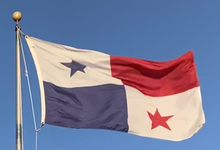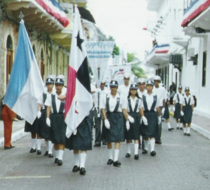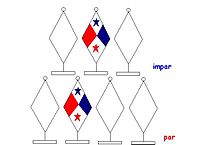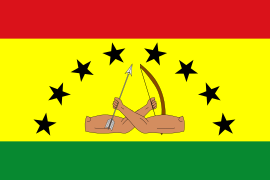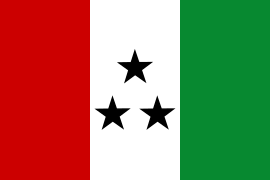Panama flag
The flag of the Republic of Panama is the best known and most important of the national symbols of the Republic of Panama. It consists of a rectangle divided into four quarters: the upper left is a five-pointed blue star on a white background; the upper right is red; the lower left is blue; and the bottom right is a red five-pointed star on a white background.
In the framework of the celebration of national holidays, every November 4 is celebrated in Panama on Day of Patriotic Symbols, as a national holiday. On the occasion of this great celebration, commemorative acts such as parades and ceremonies are held, in which tribute is paid to the flag and other national symbols.
Historical flags
Spanish Colonial Period
Union to Gran Colombia (1821-1830)
During the period of union with Gran Colombia (from 1821 to 1830), made up of the current countries of Colombia, Ecuador, Panama and Venezuela; The flag of the department of the Isthmus, an administrative and territorial division as the Isthmus of Panama was called, was the flag of Greater Colombia.
Period of Union to Colombia (1830-1903)
Since the disintegration of Gran Colombia in 1830, the countries into which it was divided continued to use the colors of this extinct nation as a sign of their common heritage. With some minor differences in their design, the colors of the flag remained constant throughout the history of these countries.
The provinces that geographically occupied the central part of the extinct Gran Colombia, which at that time comprised the former departments of Boyacá, Cauca, Cundinamarca, Magdalena and Istmo (Panama) decided to form the Republic of New Granada, to which Panama would remain united to its different denominations until the definitive separation of Colombia on November 3, 1903.
In the federalist period (from 1863-1886), the isthmian flag had the legend of "Sovereign State of Panama", but when this state was abolished it was changed to "Department of Panama".
From 1886 the flag of Panama was the same as Colombia until its separation from that country.
The Panamanian flag
The first prototype
One month before the separatist events of 1903, the future Minister Plenipotentiary of the Republic of Panama, Philippe Bunau-Varilla, on a trip to New York, showed the Panamanian separatist leader Manuel Amador Guerrero a prototype for the flag made by his wife, since he considered that the new nation urgently needed a flag as soon as possible. This flag was created on October 18, 1903 at Highland Falls on the Hudson, the mansion of John Bigelow, a businessman and friend of Bunau-Varilla.
Broadly speaking, it was a copy of the design of the United States flag: the left canton was blue and on it rested two golden suns that were joined by a gold strip that represented the position of the Isthmus of Panama within the American continent; the stripes were red and yellow, symbolizing Spain. Amador Guerrero did not like the idea of Bunau-Varilla, who despite being his friend, was not Panamanian and therefore was the least suitable person to create a symbol of Panamanian nationality. However, he gave the go-ahead with little enthusiasm and decided to transport it to Panama.
Amador Guerrero kept the prototype secretly wrapped around his body and arrived in Colón on October 26 of the same year. In an informative meeting with the Panamanian heroes, he presented the flag and there was a strong and unanimous rejection of those present; thus this prototype was discarded.
During the days before the separation, a flag design similar to that of the Panamanian navigation company Panama Steam Navigation was anonymously proposed, but it was totally discarded.
First model
Due to the urgent need to have a national emblem for the cause, and the rejection of Bunau-Varilla's prototype, the Panamanian flag was born in hiding on the night of November 1, 1903 and emerged almost immediately from the imagination of Manuel E. Amador Terreros, son of Manuel Amador Guerrero, who had a recognized ability as a draftsman and who, at the request of his parents, was assigned this task.
According to Amador Terreros, the flag represented the political moment of the time, showing the two traditional parties of the Isthmus (the Liberal and the Conservative parties), who had fought fiercely in the past and put down their hatred in an atmosphere of peace, to make a nation. For that reason, the colors that represent the parties are displayed in an equitable manner. Instead, the color white, which represents peace, exists in greater abundance. For Amador T., the stars represent the purity and strength that govern the civic life of the State on its way to fulfilling the destinies of humanity. María Ossa de Amador, stepmother of Manuel E. Amador Terreros, together with her sister-in-law Angélica Bergamoto and María Emilia Osa, daughter of Angélica, made the canvas that would represent the new Panamanian flag. The making of the flag was carried out with the greatest secrecy and secrecy possible, since they were afraid that the Colombian authorities could notice these activities. The canvas was made with wool purchased from three different stores in Panama City: Bazar Francés (white wool), La Delia (blue wool), La Villa from Paris (red undercoat).
As meetings of the separatist feat were being planned in the house of Manuel Amador Guerrero, it was decided not to make the flag in that place; Instead, the clothing was done at Angélica's house, who had good sewing skills. The clothing was done in hiding, keeping the doors and windows closed and working with a sewing machine. Due to the tense situation, they decided to move to an adjoining house that was unoccupied and three flags came out: two large and one small (result of the pieces of the three wool). On the morning of November 2, Doña María bought the fabrics and at sunset she, her sister-in-law and her niece entered the Tangui house, then abandoned, and there the first two flags of Panama were sewn. The small flag stayed in Angélica's house and later it is reported that it was taken to the United States.
When the feat of separation was successful, one of the large flags was paraded through the main streets on Tuesday, November 3, the day of the Separation of Panama from Colombia, by Alejandro de la Guardia. She was baptized on December 20 of the same year in the Plaza de Armas (now Plaza de Francia) by the Reverend Father Fray Bernardino de la Concepción García, army chaplain. The sponsors of the flag were Dr. Gerardo Ortega with Mrs. Lastenia de Lewis and Mr. José Agustín Arango with Mrs. Manuela de Arosemena.
Current design
Amador Guerrero modified the design of the flag as we know it today before the end of November. The National Assembly adopted the flag and the shield by Law 64 of 1904, provisionally adopted the flag. As the blue rectangle represents a political party, by the rules of vexillology Amador T. decided to leave the white rectangle with a blue star on top of the side of the flagpole, which indicates the ideals and peace with which the new Republic would be built. The changes were widely accepted.
The final adoption occurred through Law 4 of 1925 by the National Assembly. It was formally ratified by Law 28 of March 1941 and then by Law 34 of 1949, finally being Law 2 of 2012, in a single text, which currently regulates the symbols.
Description
According to Law number 34 of December 15, 1949, amended by Law 2 of 2012, the flag of Panama is described as follows:
The Flag of the Republic consists of a rectangle divided into four barracks like this: the first superior, near the white flag, with a five-point blue star; the second top, then described, of red colour; the first lower one, near the top, of blue color; and the second below it, of white color, with a five-point red star.
The description given by the law seems to be very simple. However, since the beginning of the republic, the meaning of the colors and stars on the flag has been known:
- Blue: Represents the Conservative Party of Colombia, which participated in the War of the Thousand Days (civil war in which Panama became involved as part of Colombia).
- Red: Represents the Liberal Party of Colombia, which also participated in the War of the Thousand Days.
- White: It represents the peace and unity that must reign in the new nation.
- The blue star: It symbolizes "purity and honesty" that will form the civic life of the homeland.
- The red star: It symbolizes “the authority and the law” that will impose the empire of these virtues.
The objective of this selection of colors was to unify the people of Panama, who were divided during the Thousand Days War and needed to forget their differences and move forward as an independent State.
Dimensions
The following dimensions have been established by national law:
- 2 m wide and 3 m long on flags flying in public buildings, warships and merchant ships
- 1,44 m wide and 1.8 m long in the pavilions of infantry and artillery bodies
- 1 square meter in the cavalry standard
- 54 cm wide and 47 cm long in the flags of the official cars
Additionally, taking into account the size of the pole, there is a proportional relation of the width of the flag in six times, for example:
| Asta size | Flag size |
|---|---|
| 6 m | 1 m x 1.5 m |
| 7 m | 1,16 m x 1,74 m |
| 8 m | 1,34 m x 2,01 m |
| 9 m | 1.5 m x 2.25 m |
| 10 m | 1,66 m x 2,49 m |
| 11 m | 1,84 m x 2.76 m |
| 12 m | 2 m x 3 m |
Daily use
The Panamanian flag must be hoisted after seven in the morning and lowered before six in the evening, and a flag in perfect condition must be hoisted. The rope of the flagpole must be white and braided with a thickness of 1/4 inch, the flagpole must have the proportion of six times the width of the flag, except in flags of special dimensions. In the following places, it must be hoisted obligatorily:
- Buildings of public institutions both autonomous and semi-autonomous.
- All boats with Panamanian tuition.
- In all foreign ships that reach ports of the Republic of Panama.
- In the buildings of the delegations, embassies and consulates of the Republic of Panama.
- In all schools of the Republic in their working hours.
When the flag is hoisted, the most due respect must be shown, also at the time of its lowering; people with hats or caps should remove them from their heads and cross their right hand over their chest with their hat on it and women should place their right hand over their heart. It should always be vigorously hoisted and ceremoniously lowered. In case of adverse weather conditions, the flag must be lowered immediately and taken to a safe place where it will be folded. At the time of lowering the flag, it must not touch the ground or anything below it.
When hoisting or lowering in a formed group, three people must face the pole on the side corresponding to the upper ring of the support:
- The one who asses and burns the flag;
- The one who holds the pulling rope;
- The one who receives or deploys the flag.
The flag and the anthem are different symbols and therefore each one has a different protocol. The flag is never raised at the time of singing the national anthem, it must always be raised before singing it. The bugle call or drum roll is optional, at the time of hoisting, according to decree 244 of 1971.
Civic act
Every Monday, at 7 in the morning and also on national holidays, in both private and official schools the civic act is carried out, it must have the following elements:
- All the staff of the board at that time.
- A three-person escort.
- A master of ceremonies.
The act itself consists of the following steps:
- Flag Walk
- Wrong of the flag
- Side events (messages, prayer, etc.)
- Song of the National Anthem
Oath
The oath to the Panamanian flag was devised by Ernestina Sucre Tapia and was adopted by Law 24 of 1959 and confirmed by Law 34 of 1949 in the single text that reflects the reforms of Law 2 of 2012. The oath is always must recite after the flag is hoisted.
It is said as follows, raising the right hand at a 90º angle and showing the palm of the hand:
- Panamanian flag: I swear to God and the Fatherland, to love you, to respect you and to defend you, as a sacred symbol of our Nation.
Using the flag on other sites
It is allowed by law that residences be decorated with pennants, banners, banners and others that are variants of the colors of the national flag. On the following occasions, decoration with the national flag or pennants, banners and the like is allowed:
- On national holidays
- On days of achievements of the Republic
- On national days of friendly countries
- On the dates of death of illustrious Panamanians as a mortaja after being authorized by the Executive Body.
The national flag by law, its use in places of nightlife, brothels, in advertising messages, commercial signs, commercial products and animals is prohibited.
Foreign citizens are allowed to use their national flag on the aforementioned occasions, also at the time of celebrations of their respective nations, as long as the Panamanian flag is placed with the same respect, size and quality as foreign flags.
Fold
To fold the flag, the presence of two people is necessary, after removing the hooks from the rope and stretching it, it is shaken to remove any foreign body that rests on the flag, before continuing it is observed if there is damage or fading of the colors, then it is folded in half, facing up the blue canton and the white one with the red star; then it is folded again so that the corner with the blue star and the red corner are facing upwards; Finally, it begins to fold in the shape of a right triangle, starting with the red corner, proceeding until it is completely folded. In the end, the white canton should cover the entire exterior of the flag.
Placement
The national flag has rules and regulations regarding its use in different events worldwide. Among these are the following:
- In the balconies is used as follows:
- Horizontal: it is placed in the form in which it binds in an asta.
- Vertical: is placed with the canton of the blue star on the upper left side of the observer.
- In the parades and stops: in the days of national holiday, of achievements of great significance for the republic or at the funerals of an illustrious Panamanian (with the remains present), the national pavilion will be placed at the head of the parade and of each delegation participating in it, with an escort. The asta must not have an inclination greater than 45o.
- In case of going other flags next to it, the flag will go in case of being a pair of flags in the right center; in case of being an odd number of flags, it will go to the center of these. In case of carrying flags behind it, they will go with the same size and quality as the Panamanian flag.
- When placed with other flags: if placed with a pair of flags, it is placed in the left center of the observer. If placed with an odd number of flags, it must be placed in the center of the group. When the Panamanian flag unfolds with a flag of another nation with the crusades, the Panamanian flag must be on the left of the observer and his flag on the flagpole of the other flag. The flag must first reach the highest point of the mast by hovering it along with the flags of other nations; when it is arrived it must come last.
- At the funerals: When used to cover a coffin, it should be placed so that the moorings remain at the head of the deceased and the white barracks with the blue star on the left side.
- He must always go to the right of the altars and a speaker.
- You must never cross two Panamanian flags.
- The flag does not bow to anyone or to anything, on any occasion.
Flag at half mast
The national flag is flown at half mast as a symbol of respect by the Panamanian people for a loss or tragic event that is occurring. To place the flag at half mast, it is fully hoisted and then lowered until it reaches half, when lowering it, it is done in reverse, hoisting the flag to the mast and then ceremoniously lowering it. The flag will be flown at half mast at the following times:
- Judgement of the President of the Republic.
- Judgement of a former President of the Republic.
- Judgement of the Vice-President or Ministers of State.
- Failure of a senior official of the national government.
- Death of a National Assembly Representative.
- Judge of the Supreme Court of Justice.
- Death of an illustrious Panamanian (winner of any national or Panamanian order that has emerged internationally).
- Failure of an illustrious character worldwide.
- When a natural disaster of great magnitude occurs to a friendly nation.
Sacrilege
According to the laws that govern the use of national symbols, the flag is subject to improper use, disrespect or irreverence in the following cases:
- Being cut or burned in some protest
- To be used in commercial articles by incorporating it into a commercial or political brand or slogan.
- Appear in some advertising guidelines that associate it as part of the product.
- Be packed into nightlife sites or place in dubious reputation or liquor expendium sites.
When incurring in one of these situations and depending on the degree of disrespect given to the national flag, the Law establishes sanctions after they are reported to the Mayor of the place where the abuse occurred.
Destruction
When the national flag reaches the end of its period of use (faded colors, tears), it will be removed from functions and burned in a solemn ceremony.
The flags must be burned in a public and open place so that anyone who wishes to pay their last respects to the national flag can attend. In addition to this, the following elements must exist:
- An oven to incinerate the flags
- A tray to collect the ashes
- A hole in the earth to deposit the ashes
- The flags that will be burned
The oven is the main element of the ceremony, it must be open and made of heat-resistant material (usually they are built from oil tanks split in half), with a hole at the bottom to let the ashes out; The oven must have an expanded steel mesh to separate the flags from the fuel and the legs of the oven must be iron, 1/4 inch wide and 24 inches long. According to the rules of flag cremation, only mangrove wood can be used as fuel and it can only ignite itself without the help of fossil fuels.
To the cremation ceremony, each Government will invite the people, institutions and forces that it deems appropriate, such as:
- Representatives of institutions that will cremate their flags
- A representative of Girl Guides
- Representatives of civic clubs
- A community representative where the event takes place
Before proceeding with the cremation, a speech is made about the national flag and its importance in the institutions that will cremate their flags; after this, the oath to the flag is recited, written by the Panamanian Ernestina Sucre (founder of the Girl Guides). Finally, we proceed to burn the previously folded flags.
When finished, the ashes are collected and buried with due respect.
Timeline of historical flags of Panama
Provincial and county flags
Some indigenous provinces, districts and regions of the country have their own flag, some of them are shown below:
Flags of provinces and regions of Panama
Contenido relacionado
National Coat of Arms of Mexico
Lost in translation
Sculpture from italy








